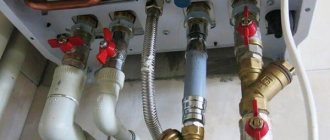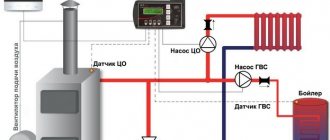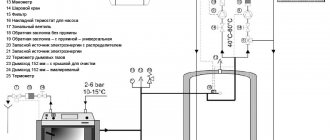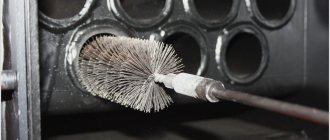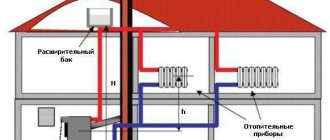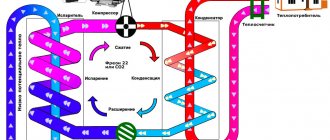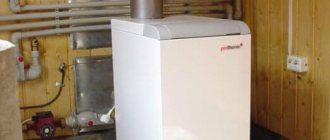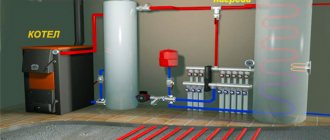Construction and operation of gas-wood boilers
A universal gas-wood boiler for home heating, available in three different modifications, differing in design and functionality.
- Module with the possibility of conversion to gas.
- A boiler that has two combustion chambers at once, separately for wood and gas.
- Heat generator with built-in electric heating element.
Combined boilers of mixed type, for gas and wood, have built-in automation that fully automates the combustion process. After the wood burns in the firebox, the module automatically switches to gas or electricity. For domestic hot water, the water is heated by an electric heating element.
Simultaneous installation of a wood and gas boiler in one system requires significant financial costs. The purchase and installation of universal equipment reduces costs by 30-40%.
Bi-fuel wood-gas boilers
Combined gas-wood boilers are widely used in domestic settings. The design includes the following components:
- Combustion chamber - made of steel or cast iron. One or two fireboxes are installed in the design. A modification with two combustion chambers is more convenient. A gas burner is installed in the lower firebox. In the upper chamber there are grates for burning wood.
- Heating and hot water circuits - manufacturers produce models designed exclusively for heating (with the possibility of subsequent connection to an indirect heating boiler), as well as for producing hot water and heating rooms. The latter are equipped with two circuits. DHW is heated using a flow method.
Heating of water for domestic hot water, depending on the performance of the boiler heater, reaches 700 l/hour. There are modifications with built-in storage capacity for 40-120 liters of water.
Electric-gas-wood boilers
Combined heating boilers, gas, wood and electricity, have a device reminiscent of what dual-fuel units use. The main difference is the installed electric heating element. The operating principle of combined boilers, gas, wood, electricity, is as follows:
- The main type of fuel is firewood. After the wood is burned, the gas burner turns on automatically. The heating process continues without stopping.
- The heating element is used to maintain a minimum temperature of the coolant after the gas and firewood have run out. Operation in antifreeze mode is allowed. An electric heating element maintains a minimum temperature in the heating system, preventing the water circuit from freezing.
Some universal heating boilers - gas, wood, electricity - use the principle of gas generation in their operation, which increases the battery life to 6-12 hours, from one load of logs.
Advantages and disadvantages of gas boilers
Gas boilers are modern and safe heating devices. They are often installed in many settlements where the gas supply line runs.
A gas heating system has a number of advantages:
- ease of use thanks to a fully automated workflow;
- the ability to heat both small rooms and buildings with a huge area;
- profitability due to increased efficiency and the ability to release more energy than consume;
- safety of use due to automatic ignition of the boiler in case of unexpected flame extinction;
- long operational period - the service life of many boilers is fifteen years;
- good environmental performance - when gas burns, a minimum amount of harmful substances is released, soot and soot are not formed.
There are few disadvantages to a gas heating system:
- mandatory installation of automation to prevent gas leaks;
- special requirements for the room in which the unit is installed;
- the need to build a chimney;
- Carrying out annual inspection and cleaning of the boiler.
Installation of a gas heating device is carried out only with the permission of the Gaztekhnadzor service.
In buildings with an area of less than one hundred square meters, it is more profitable to use electric boilers. Depending on the method of placement of the heating unit, its power, size and additional functions, floor-mounted, wall-mounted, two- and single-circuit or condensing gas boilers are produced.
Recommendation for choosing a gas and wood boiler
The choice of combined heating boilers for wood and gas is influenced by the technical parameters of the heated building and the need to automate the combustion process
Pay attention to the presence or absence of additional functions in the device
The main selection criteria are:
- Performance - one kilowatt of power is enough to heat 10 m² of a building. The boiler is selected in accordance with the heating needs of the building. For a room of 100 m², you will need to install a 10 kW model, for 200 m² - 20 kW, etc.
- The presence of a hot water supply circuit - choosing a universal boiler with hot water supply is somewhat more difficult. During operation, a certain amount of power will be expended to heat domestic water. Therefore, the calculation of the required power of double-circuit boilers is carried out taking into account a reserve of thermal energy of 15-20%. For a typical building of 100 m², the minimum power of heating equipment will be 12 kW.
- Built-in heating element - the presence of an electric heater significantly increases the functionality of the boiler. Automatic switching to heating by heating elements occurs thanks to the installed sensitive controller. In the settings of most models there is a mode that allows you to maintain minimal heating of the coolant (+5-10 ° C) and spend a minimum amount of electricity, which is convenient if you need to leave the building for some time in winter, without full heating.
- Design features - as already noted, multi-fuel boilers can have one universal combustion chamber designed for alternating use of gas and firewood, or separate fireboxes for each type of fuel. The second option is preferable due to the fact that the boiler is switched from wood to gas automatically.
When connecting the boiler to the main gas, you will need to make a project and obtain all the necessary permits for commissioning. The installation rules are the same as for any other gas equipment.
Main manufacturers of wood-gas boilers
Another important aspect that influences the choice of a dual-fuel boiler is the country of manufacture and brand of the heating unit. High-quality equipment is manufactured in the EU, Russia and Ukraine:
- Ukrainian and Russian combined boilers are fully adapted to the realities of domestic operation and are insensitive to fuel quality and voltage drops in the network. Heating boilers for wood and gas, made in Russia, are produced by several leading manufacturers: Kupper PRO (Teplodar company), Zota MIX, Karakan (Novosibirsk concern STEN), PARTNЁR (Novosibirsk manufacturer KOSTYOR), STS (Ukrainian manufacturer Steel Solid Fuel Systems) .
- European combined boilers - products on the heating equipment market are offered by more than a dozen different companies. The following brands are in constant demand: Wirbel (an Austrian-German company of the same name), Jaspi (a Finnish concern specializing in the production of solid fuel boilers).
In terms of build quality and reliability, European units are somewhat ahead of their domestic counterparts. There are clearly noticeable shortcomings in Russian boilers, especially with regard to automation of the device and operation in gas generation mode.
The quality of Russian equipment is constantly improving, and the wishes of customers are taken into account. Over time, we can expect the release of competitive products.
How much does gas and wood burning equipment cost?
Pricing policy depends on the location of the manufacturer’s plant and brand recognition. A multi-fuel boiler PARTNЁR, a Russian manufacturer, will cost 22-24 thousand rubles, depending on power and configuration.
The Finnish analogue of Jaspi costs from 120 to 150 thousand rubles. Significant difference. True, the consumer, for this money, gets an almost completely autonomous station with a storage capacity and automation that fully controls the combustion process. In the case of a Russian boiler, all processes will have to be adjusted manually.
Independent conversion of a gas boiler for firewood often costs the approximate cost of a conventional domestically produced multi-fuel unit.
Criteria for choosing gas-wood boilers
The main parameter of any heating equipment is its power , the correct choice of which ensures a comfortable room temperature at minimal cost.
If you don’t make complex calculations, then when choosing a boiler you need to keep in mind that 1 kW of thermal power is required for 30 m³ in a well-insulated room. Thermal engineering calculations of professionals are more accurate and take into account factors such as the thermal insulation of the room, the presence of other types of heating, the functional purpose of the room, etc. Detailed article on calculating boiler power. Since one of the energy resources of this type of boiler is gas, its pressure in the network should be taken into account. Boiler performance decreases at low gas pressure. In this case, a possible lack of power is taken into account.
The next important parameter by which a boiler is selected is its purpose . If the functions of the boiler include only heating, then you can opt for single-circuit equipment. In cases where it is necessary to provide housing with hot water supply, a double-circuit boiler is purchased. This device comes in two types: with a built-in boiler or with a built-in coil. The first one always has 40-60 liters of hot water ready. The second type of device is inferior to the boiler in terms of water volume, but at the same time has more compact dimensions, weight and saves more fuel. You can always connect an additional indirect heating boiler to a single-circuit boiler.
When purchasing a boiler, you must require an official certificate. Without this document, it will be difficult to register heating equipment and obtain permission to connect it to gas supply systems.
Design Features
The range of heating boilers is represented by different models. Some run on gas, others on electricity, and others on liquid fuel. Each type has its own operational advantages and disadvantages. The disadvantages of using certain installations haunt designers and technicians. So they decided to combine some models, and combined heating devices were born. They can operate, for example, on solid fuel and gas simultaneously.
This combination made it possible to minimize emergency risks and organize the operation of the same solid fuel boiler in autonomous mode. How do such installations work, and where is their use more than justified? As a rule, universal boilers are always equipped with an additional number of pipes. They can be used to connect underfloor heating, heating radiators, a greenhouse control system, heating water in a swimming pool or heating a bathhouse.
The gas burner in such a boiler is located below the combustion chamber, where firewood, briquettes, sawdust or coal are placed. Therefore, if necessary and switching, it allows you to completely burn the remaining solid fuel. If work is switched to solid fuel, the gas burner closes automatically. For ease of use, the steel heat exchanger responsible for heating the room passes through the entire body. All walls are thermally insulated with special mineral wool, so the efficiency of the unit is almost 92%. And this is a very high figure.
The heat exchanger for supplying hot water is made of copper and is located in the upper part of the installation. Copper is not afraid of corrosion, so the service life of the coil is equal to the service life of the entire device as a whole. Universal boilers have lever and air dampers that ensure the supply of the required portion of air.
How the installation works
The operating principle of a gas-wood boiler is extremely simple. The design uses two autonomous cameras. The furnace room is located above the gas room. This feature allows you to use two types of fuel simultaneously. Gas burners can operate at low pressure. Therefore, you can often see models that are connected not to central gas lines, but to liquefied gas cylinders.
Note! If there is a power outage, the gas-wood boiler will not be able to operate on gas. And all because the products of its combustion in this case will not be independently discharged through the chimney to the outside, and condensate instantly accumulates on its walls, clogging the chimney
If there is no light in the house, the boiler is heated exclusively with wood.
Advantages of installations
There are quite a lot of advantages of gas-wood boilers, so we will outline only the most basic ones:
- The main factor is the opportunity to save money and use cheap firewood instead of expensive blue fuel. If you run out of wood, you can switch to gas in automatic mode.
- The combined design allows the use of autonomous heating. Gas ensures operation of the installation at night without additional fuel loading. It’s also nice to come home after work to a well-heated house, knowing that the gas will maintain the desired temperature when there is no one to throw firewood into the stove.
- Universal combi boilers can have one or two circuits, so you can use the installation not only for heating, but also for supplying hot water for technical needs. Today, universal gas-wood boilers are equipped with storage boilers, and there are models that can heat water to the desired temperature using a flow-through method. The choice is great, and that makes me happy.
But before deciding to purchase such installations, experts recommend studying the features of their operation and disadvantages.
Organization of an open system with a heat accumulator
- Do-it-yourself installation of shut-off valves on two fittings of a wood-burning boiler.
- Connecting the expansion tank. It must be placed so that it is higher than all the trim elements. The pressure under which a solid fuel boiler supplies water often exceeds the pressure under which coolant is supplied from a gas boiler connected to the cylinder. To equalize these values, you need to correctly configure the open expansion tank.
- Installation of taps on the pipes of the heat accumulator.
- Connection of the heat accumulator and the boiler with two pipes.
- Connecting two tubes to pipes located between the heat accumulator and the boiler. They are installed near the taps, which are located near the battery fittings, or at a short distance from the shut-off valves. Shut-off valves are mounted on these tubes. Thanks to these pipes, it will be possible to use a solid fuel boiler bypassing the heat accumulator.
- Jumper insert. It connects the supply and return pipes located between the wood-burning boiler for the home and the heat accumulator. This jumper is attached to the supply line by welding or using fittings, and to the return line using a three-way valve. A small circle is formed through which the coolant will circulate until it heats up to 60 °C. Afterwards, the water will move in a large circle through the heat accumulator.
- Connecting the filter and pump. They are mounted on the return line in the place between the three-way valve and the boiler heat exchanger pipe . To do this, a U-shaped tube is connected in parallel to the line, in the middle of which there is a pump with a filter. There should be taps before and after these elements. This solution allows you to create a bypass through which the coolant will flow in the event of a lack of electricity.
Standards for installing a gas-wood heating boiler
The installation of a gas boiler with the possibility of burning wood is subject to higher requirements than for conventional solid fuel equipment. Operating and connection standards are described in SNiP, SP and PPB. In particular, it states:
- Boiler room - a room with a total area of at least 12 m² and a ceiling height of 2.2 m is selected for installing the boiler.
- The walls and floor are lined with non-combustible materials: plaster and ceramic tiles.
- Supply and exhaust ventilation is required. For better air flow, the door frame is installed without a lower threshold.
- The boiler is connected to the electrical network through automatic circuit breakers located outside the boiler room. Modern multi-fuel small-sized boilers (gas, wood and electricity) have protection against power surges. Despite this, manufacturers recommend connecting through an uninterruptible power supply with a built-in stabilizer.
- Natural lighting is a must. The dimensions of window openings are calculated depending on the performance of the boiler.
- Universal heating boilers for gas and wood, with a capacity of up to 40 kW, can be installed in any room used for household needs. A heat generator over 40 kW is installed in a separate room intended exclusively for the needs of the boiler room.
- Where the chimney passes through the floor slabs and roofing pie, fire-proof cuts are provided. The pipe is insulated with a non-flammable mineral sealant.
- A spark arrester and a deflector are installed on the chimney head to increase the draft force.
When connected to the main gas, the first start-up of the boiler is carried out in the presence of an inspector. If there are no violations, the Gas Service inspector will make a note in the equipment passport about its commissioning.
Pros and cons of using wood and gas boilers
Heating boilers for the home, operating on wood, gas and electricity, as practice has shown, are easy to use and easily replace two single-fuel units. The advantages of universal multi-fuel models are:
- Automation of the combustion process.
- Long operating time from one load of firewood.
- Lower cost compared to two boilers operating separately on gas and wood.
- Quick switching to a backup fuel source.
- Ability to work in an unheated building to prevent freezing of the coolant.
- Small dimensions.
- Meeting the needs of hot water supply - floor-mounted double-circuit heating combined gas-wood boilers, operating as a flow-through water heater. Single-circuit analogues, connected to an indirect heating boiler.
Household hot water gas-wood heating boilers have several disadvantages:
- High price.
- Heavy weight due to the fact that several combustion chambers are built into the design.
This is where the disadvantages of universal boilers end. It is clear that domestic equipment has shortcomings, but in general, even Russian units work flawlessly. Multi-fuel boilers are easy to use and in many ways superior to units that run on only one type of fuel.
Calculation of power and temperature of a warm water floor
Combined heating boilers wood gas description and application
Many manufacturers of heating equipment, in order to increase the competitiveness of their products and create more comfortable conditions for their customers, have seriously begun to produce combined heating boilers. These types of boilers are known for the fact that they can simultaneously operate on several types of fuel. Today you can find boilers that can operate on four types of fuel at once. But due to their low functionality, combined heating boilers running on gas and wood have achieved particular popularity among the population.
Combined heating boilers wood gas
Video:
Heating without gas: do-it-yourself utilities. How to heat a house without gas, and even with interruptions in electricity? Many summer residents face this problem.
Well-known YouTube blogger Vladimir Sukhorukov, using the example of his home, will talk about how you can organize a heating system with a homemade boiler and automation that will provide you with heat in any situation.
Diesel heating and other engineering systems in a one-story house.
The homeowner will tell you:
- Why did he choose a boiler running on diesel fuel to heat his country cottage?
- How much does it cost to operate a heating system powered by diesel fuel?
- What else is planned to be done to save more on heating costs?
- Why did he refuse the heated floor system?
Energy efficient house_2: do it yourself. The video features a cheap option for heating a cottage with electricity and a non-standard design for a country frame house, which was built with your own hands.
Air heating: an alternative to gas. Lack of gas is a common problem in suburban communities. Air heating can be a good alternative to mains gas, which will provide a comfortable temperature in the house even in the most severe cold.
Preparing systems for the heating season. In the video, a specialist explains how to prepare the heating system of a country house for the upcoming winter season.
Are there any special features in operation?
When purchasing a combined boiler with wood and gas heating, you need to take into account several operational points, without which the use of firewood as the main source of heat can lead to the fact that the universal method will cause considerable problems.
So, during its operation, a wood-burning boiler gradually clogs the chimney with soot, which must be periodically cleaned. Without this, the efficiency of smoke removal will gradually decrease, until problems with ignition, smoke in the room, etc. appear.
Rice. 4 Chimneys require regular cleaning
If gas or electric heating can operate continuously, then a wood-burning boiler burns out completely after a maximum of 3-4 hours, after which the heating system inevitably begins to cool down. Loading a new portion is done manually, which requires the owner's home. Therefore, combined modifications with wood or pellet fuel are often used, if possible, in gas heating mode.
Pellets partially allow you to automate the heating procedure with wood fuel, but you still have to monitor the process. And the reserve must be created in advance, otherwise you may be left without heating during the coldest period of the year.
